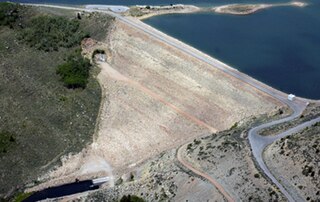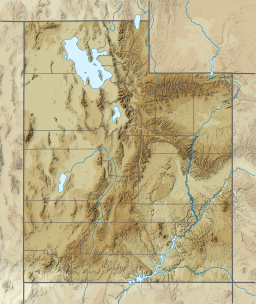
The Deschutes River in central Oregon is a major tributary of the Columbia River. The river provides much of the drainage on the eastern side of the Cascade Range in Oregon, gathering many of the tributaries that descend from the drier, eastern flank of the mountains. The Deschutes provided an important route to and from the Columbia for Native Americans for thousands of years, and then in the 19th century for pioneers on the Oregon Trail. The river flows mostly through rugged and arid country, and its valley provides a cultural heart for central Oregon. Today the river supplies water for irrigation and is popular in the summer for whitewater rafting and fishing.

The Truckee River is a river in the U.S. states of California and Nevada. The river flows northeasterly and is 121 miles (195 km) long. The Truckee is the sole outlet of Lake Tahoe and drains part of the high Sierra Nevada, emptying into Pyramid Lake in the Great Basin. Its waters are an important source of irrigation along its valley and adjacent valleys.

Bear Lake is a natural freshwater lake on the Idaho–Utah border in the Western United States. About 109 square miles (280 km2) in size, it is split about equally between the two states; its Utah portion comprises the second-largest natural freshwater lake in Utah, after Utah Lake. The lake has been called the "Caribbean of the Rockies" for its unique turquoise-blue color, which is due to the refraction of calcium carbonate (limestone) deposits suspended in the lake. Its water properties have led to the evolution of several unique species of fauna that occur only within the lake. Bear Lake is over 250,000 years old. It was formed by fault subsidence that continues today, slowly deepening the lake along the eastern side.

Flaming Gorge Reservoir is the largest reservoir in Wyoming, on the Green River, impounded behind the Flaming Gorge Dam. Construction on the dam began in 1958 and was completed in 1964. The reservoir stores 3,788,900 acre-feet (4.6735×109 m3) of water when measured at an elevation of 6,040 feet (1,841 m) above sea-level (maximum).

The cutthroat trout(Oncorhynchus clarkii) is a fish species of the family Salmonidae native to cold-water tributaries of the Pacific Ocean, Rocky Mountains, and Great Basin in North America. As a member of the genus Oncorhynchus, it is one of the Pacific trout, a group that includes the widely distributed rainbow trout. Cutthroat trout are popular gamefish, especially among anglers who enjoy fly fishing. The common name "cutthroat" refers to the distinctive red coloration on the underside of the lower jaw. The specific name clarkii was given to honor explorer William Clark, coleader of the Lewis and Clark Expedition.

The Bonneville cutthroat trout is a subspecies of cutthroat trout native to tributaries of the Great Salt Lake and Sevier Lake. Most of the fish's current and historic range is in Utah, but they are also found in Idaho, Wyoming, and Nevada. This is one of 14 or so recognized subspecies of cutthroat trout native to the western United States.

The Payette River is an 82.7-mile-long (133.1 km) river in southwestern Idaho and is a major tributary of the Snake River.

The Price River is a 137-mile-long (220 km) southeastward flowing river in Carbon, Utah and Emery counties in eastern Utah. It is tributary to the Green River, itself a tributary to the Colorado River.

Lahontan cutthroat trout is the largest subspecies of cutthroat trout, and the state fish of Nevada. It is one of three subspecies of cutthroat trout that are listed as federally threatened.

The Yellowstone cutthroat trout is a subspecies of the cutthroat trout. It is a freshwater fish in the salmon family. Native only to a few U.S. states, their original range was upstream of Shoshone Falls on the Snake River and tributaries in Wyoming, also across the Continental Divide in Yellowstone Lake and in the Yellowstone River as well as its tributaries downstream to the Tongue River in Montana. The species is also found in Idaho, Utah and Nevada.
The Central Utah Project is a US federal water project that was authorized for construction under the Colorado River Storage Project Act of April 11, 1956, as a participating project. In general, the Central Utah Project develops a portion of Utah's share of the yield of the Colorado River, as set out in the Colorado River Compact of 1922.

Soldier Creek Dam is an earthen dam on the Strawberry River, located within the Uinta National Forest in southern Wasatch County, Utah, United States.

Taylor Creek is a 2.2-mile-long (3.5 km) northward-flowing stream originating in the Fallen Leaf Lake and culminating at Baldwin Beach at Lake Tahoe, about 1 mile (1.6 km) west of Camp Richardson in El Dorado County, California.

Spooner Lake is a man-made reservoir located just north of the intersection of Highway 50 and Highway 28 near Spooner Summit, a pass in the Carson Range of the Sierra Nevada leading to Carson City, Nevada from Lake Tahoe. It is located in Lake Tahoe – Nevada State Park.
Fishing in Colorado has brought in a large amount of revenue for the state. In 2019 Colorado Parks and Wildlife estimated outdoor recreation contributed roughly 62 billion dollars to the state economy. Fishing was reported to be the 5th most popular outdoor activity and 110, 511 fishing and hunting combination licenses were sold. Ice fishing makes up part of this total fishing revenue and is a common annual sport for Colorado residents and out-of-state visitors. There is no legal definition of ice fishing season. Rather, people begin to ice fish once the lakes freeze over with thick enough ice. Colorado Parks and Wildlife also recommend that people always ice-fish with another person. Typically, this starts in December and ends in April for Colorado. Lakes size, depth, elevation, and seasonal weather can cause variance to the season. Once the lakes freeze over with thick enough ice, anglers go out onto the ice, drill holes through the ice, and fish for a variety of species.

Cooper Lake is an alpine freshwater lake located on the southern stretch of the Alpine Lakes Wilderness in Kittitas County, Washington. Because of its proximity to Cle Elum Lake and Kachess Lake, Cooper Lake is a popular area for hiking, camping and fishing. Cooper Lake, where two-pole fishing is permitted, is stocked annually with Kokanee salmon and several species of trout fish. Cooper Lake is the starting point for trails that lead to other Alpine lakes in the vicinity, including the Pete Lake and Spectacle Lake at the base of Chikamin Peak.

Birch Creek is a 6.1-mile-long (9.8 km) northeastward-flowing stream originating on the western slope of the Bear River Range in Franklin County, Idaho, United States. Its mouth is at the confluence with Mink Creek about 12 miles (19 km) northwest of Preston, Idaho. In turn, Mink Creek flows southwest to its confluence with the Bear River and, from there, its flows terminate in the Great Salt Lake.

Birch Creek is a northwesterly-flowing 8.4 miles (13.5 km) stream in Beaver County, Utah. It originates on the western slope of Birch Creek Mountain in the Tushar Mountains in Fishlake National Forest, and its waters flow west into South Creek, then under Interstate 15 south of the town of Beaver, and thence to the Beaver River, and ultimately to the Sevier River and Lake.

















